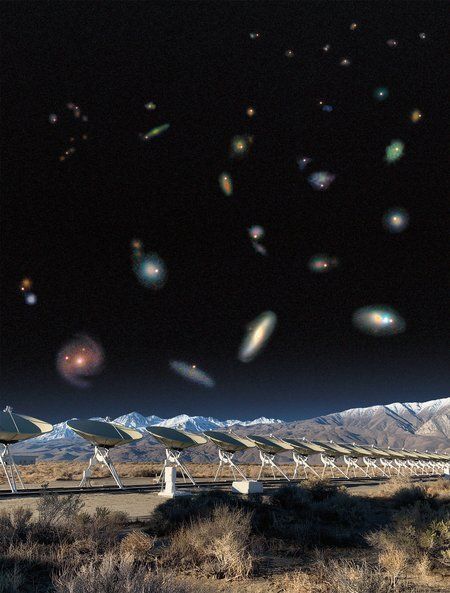8.11.2024
Results from Caltech's Deep Synoptic Array-110 provide new clues about how magnetars form

This photo montage shows the antennas of the Deep Synoptic Array-110, which are used to discover and pinpoint the locations of fast radio bursts (FRBs). Above the antennas are images of some of the FRB host galaxies as they appear on the sky. The galaxies are remarkably large, challenging models that describe FRB sources.
Since their discovery in 2007, fast radio bursts—extremely energetic pulses of radio-frequency light—have lit up the sky repeatedly, leading astronomers on a chase to uncover their origins. Currently, confirmed fast radio bursts, or FRBs, number in the hundreds, and scientists have assembled mounting evidence for what triggers them: highly magnetized neutron stars known as magnetars (neutron stars are a type of dead star). One key piece of evidence came when a magnetar erupted in our own galaxy and several observatories, including Caltech's STARE2 (Survey for Transient Astronomical Radio Emission 2) project, caught the action in real time.
Now, reporting in the journal Nature, Caltech-led researchers have uncovered where FRBs are more likely to occur in the universe—massive star-forming galaxies rather than low-mass ones. This finding has, in turn, led to new ideas about how magnetars themselves form. Specifically, the work suggests that these exotic dead stars, whose magnetic fields are 100 trillion times stronger than Earth's, often form when two stars merge and later blow up in a supernova. Previously, it was unclear whether magnetars form in this way, from the explosion of two merged stars, or whether they might form when a single star explodes.
"The immense power output of magnetars makes them some of the most fascinating and extreme objects in the universe," says Kritti Sharma, lead author of the new study and a graduate student working with Vikram Ravi, an assistant professor of astronomy at Caltech. "Very little is known about what causes the formation of magnetars upon the death of massive stars. Our work helps to answer this question."
The project began with a search for FRBs using the Deep Synoptic Array-110(DSA-110), a Caltech project funded by the National Science Foundation and based at the Owens Valley Radio Observatory near Bishop, California. To date, the sprawling radio array has detected and localized 70 FRBs to their specific galaxy of origin (only 23 other FRBs have been localized by other telescopes). In the current study, the researchers analyzed 30 of these localized FRBs.
"DSA-110 has more than doubled the number of FRBs with known host galaxies," says Ravi. "This is what we built the array to do."
Although FRBs are known to occur in galaxies that are actively forming stars, the team, to its surprise, found that the FRBs tend to occur more often in massive star-forming galaxies than low-mass star-forming galaxies. This alone was interesting because the astronomers had previously thought that FRBs were going off in all types of active galaxies.
With this new information, the team started to ponder what the results revealed about FRBs. Massive galaxies tend to be metal-rich because the metals in our universe—elements that are manufactured by stars—take time to build up over the course of cosmic history. The fact that FRBs are more common in these metal-rich galaxies implies that the source of FRBs, magnetars, are also more common to these types of galaxies.
Stars that are rich in metals—which in astronomical terms means elements heavier than hydrogen and helium—tend to grow larger than other stars. "Over time, as galaxies grow, successive generations of stars enrich galaxies with metals as they evolve and die," Ravi says.
What is more, massive stars that explode in supernovae and can become magnetars are more commonly found in pairs. In fact, 84 percent of massive stars are binaries. So, when one massive star in a binary is puffed up due to extra metal content, its excess material gets yanked over to its partner star, which facilitates the ultimate merger of the two stars. These merged stars would have a greater combined magnetic field than that of a single star.
"A star with more metal content puffs up, drives mass transfer, culminating in a merger, thus forming an even more massive star with a total magnetic field greater than what the individual star would have had," Sharma explains.
In summary, since FRBs are preferentially observed in massive and metal-rich star-forming galaxies, then magnetars (which are thought to trigger FRBs) are probably also forming in metal-rich environments conducive to the merging of two stars. The results therefore hint that magnetars across the universe originate from the remnants of stellar mergers.
In the future, the team hopes to hunt down more FRBs and their places of origin using DSA-110, and eventually the DSA-2000, an even bigger radio array planned to be built in the Nevada desert and completed in 2028.
"This result is a milestone for the whole DSA team. A lot of the authors on this paper helped build the DSA-110," Ravi says. "And the fact that the DSA-110 is so good at localizing FRBs bodes well for the success of DSA-2000."
The study titled "Preferential Occurrence of Fast Radio Bursts in Massive Star-Forming Galaxies" was funded by the National Science Foundation. Other Caltech authors include Liam Connor, Casey Law, Stella Koch Ocker, Myles Sherman, Nikita Kosogorov, Jakob Faber, Gregg Hallinan, Charlie Harnach, Greg Hellbourg, Rick Hobbs, David Hodge, Mark Hodges, James Lamb, Paul Rasmussen, Jean Somalwar, Sander Weinreb, David Woody, Shreya Anand, Kaustav Kashyap Das, Yu-Jing Qin, Sam Rose, Dillon Z. Dong, Jessie Miller, and Yuhan Yao. Joel Leja from The Pennsylvania State University is also an author.
Quelle: California Institute of Technology
